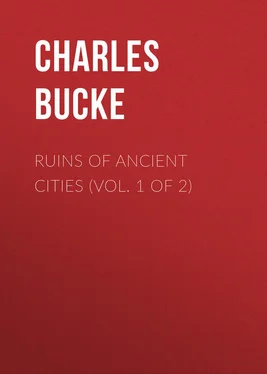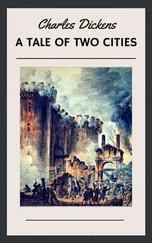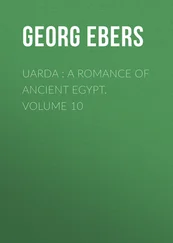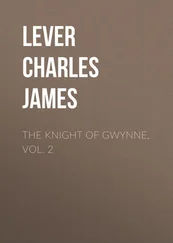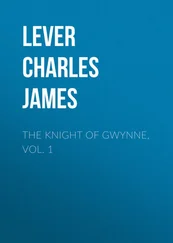Charles Bucke - Ruins of Ancient Cities (Vol. 1 of 2)
Здесь есть возможность читать онлайн «Charles Bucke - Ruins of Ancient Cities (Vol. 1 of 2)» — ознакомительный отрывок электронной книги совершенно бесплатно, а после прочтения отрывка купить полную версию. В некоторых случаях можно слушать аудио, скачать через торрент в формате fb2 и присутствует краткое содержание. Жанр: foreign_antique, foreign_prose, на английском языке. Описание произведения, (предисловие) а так же отзывы посетителей доступны на портале библиотеки ЛибКат.
- Название:Ruins of Ancient Cities (Vol. 1 of 2)
- Автор:
- Жанр:
- Год:неизвестен
- ISBN:нет данных
- Рейтинг книги:4 / 5. Голосов: 1
-
Избранное:Добавить в избранное
- Отзывы:
-
Ваша оценка:
- 80
- 1
- 2
- 3
- 4
- 5
Ruins of Ancient Cities (Vol. 1 of 2): краткое содержание, описание и аннотация
Предлагаем к чтению аннотацию, описание, краткое содержание или предисловие (зависит от того, что написал сам автор книги «Ruins of Ancient Cities (Vol. 1 of 2)»). Если вы не нашли необходимую информацию о книге — напишите в комментариях, мы постараемся отыскать её.
Ruins of Ancient Cities (Vol. 1 of 2) — читать онлайн ознакомительный отрывок
Ниже представлен текст книги, разбитый по страницам. Система сохранения места последней прочитанной страницы, позволяет с удобством читать онлайн бесплатно книгу «Ruins of Ancient Cities (Vol. 1 of 2)», без необходимости каждый раз заново искать на чём Вы остановились. Поставьте закладку, и сможете в любой момент перейти на страницу, на которой закончили чтение.
Интервал:
Закладка:
All travellers agree that its present appellation is a misnomer; yet it is known that a monument of some kind was erected at Alexandria to the memory of Pompey, which was supposed to have been found in this remarkable column. Mr. Montague thinks it was erected to the honour of Vespasian. Savary calls it the Pillar of Severus. Clarke supposes it to have been dedicated to Hadrian, according to his reading of a half-effaced inscription in Greek on the west side of the base; while others trace the name of Diocletian in the same inscription. No mention occurring of it either in Strabo or Diodorus Siculus, we may safely infer that it did not exist at that period; and Denon supposes it to have been erected about the time of the Greek Emperors, or of the Caliphs of Egypt, and dates its acquiring its present name in the fifteenth century. It is supposed to have been surmounted with an equestrian statue. The shaft is elegant and of a good style; but the capital and pedestal are of inferior workmanship, and have the appearance of being of a different period.
In respect to the inscription on this pillar, there are two different readings: – It must, however, be remembered, that many of the letters are utterly illegible.
Dr. Clarke's version is —
Now, since it is known that Hadrian lived from A. D. 76 to 130, it seems clear that Pompey has no connexion with this pillar, and that it ought no longer to bear his name. Some writers, however, are disposed to believe that the inscription is not so old as the pillar, and this is very likely to be the case.
This celebrated pillar has of late years been several times ascended. The manner, as we have before stated, was this: – "By means of a kite, a strong cord was passed over the top of the column, and securely fastened on one side, while one man climbed up the other. When he had reached the top, he made the rope still more secure, and others ascended, carrying with them water of the Thames, of the Nile, and of one of the Grecian Islands: a due supply of spirits was also provided, and thus a bowl of punch was concocted; and the healths of distinguished persons were drunk. This ascent was made when the British fleet was in Egypt, since which time the ascents have been numerous; for, according to Mr. Webster, the crew of almost every man-of-war which has been stationed in the port of Alexandria have thought the national honour of British tars greatly concerned in ascending the height of fame, or, in other words, the famous height which Pompey's pillar affords. It is not unusual for a party to take breakfast, write letters, and transact other matters of business on this very summit; and it is on record that a lady once had courage to join one of these high parties."
Besides this there are two obelisks. The first is of granite, and is called Cleopatra's Needle, but it has become nearly certain that it was removed hither from Heliopolis, and it is now, therefore, regarded as the obelisk of Thothmes III. Its fallen companion also bears the name of Thothmes, and, in the lateral lines of Remeses II, the supposed Sesostris. One of these is still upright on its base; the other is thrown down and almost entirely buried in the sand. "The former," says Sonnini, "shows what the hand of man can do against time; the other what time can do against the efforts of man."
They are both of red granite. According to a survey made by Dr. Clarke, the base of the prostrate one measures seven feet square, and the length is sixty-six feet. They are both covered with hieroglyphics cut into the stone to the depth of two inches. These two monuments served to decorate one of the entrances to the palace of the Ptolemies, the ruins of which are contiguous 25 25 After the English were in possession of Alexandria, a subscription was opened by the military and naval officers for the purpose of removing the prostrate obelisk to England. With the money so raised they purchased one of the vessels, sunk by the French in the old port of Alexandria: this was raised, and prepared for the reception of the obelisk. The French had already cleared away the heaps of rubbish which enveloped it, and the English turned it round, and found it in a fine state of preservation. It was moved towards the vessel, when an order arrived from the Admiralty, prohibiting the sailors from being employed at this work. No further attempts have been made to remove this fine monument to Europe. – Anon.
.
Nothing 26 26 Wilkinson.
, however, which remains in the vicinity of Alexandria attests its greatness more satisfactorily than the catacombs on the coast, near the Necropolis. Their size, although remarkable, is not so striking as the elegant symmetry, and proportion of the architecture in the first chamber, which is of the best Greek style, and not to be equalled in any other part of Egypt. 27 27 Sonnini.
They are at a short distance from the canal, and are galleries, penetrating a prodigious way under ground, or rather into the rock. They are supposed to have been at first the quarries, which furnished stones for the construction of the edifices of Alexandria; and, after having supplied the men of that country with the materials of their habitations, while they lived, are themselves become their last abode after death. Most of these subterraneous alleys are in a ruinous state. In the small number of those which it is possible to penetrate, are seen, on both sides, three rows of coffins, piled on each other. At the entrance of some of these galleries there are separate apartments, with their coffins; reserved, no doubt, for the sepulture of particular families, or of a peculiar order of citizens. These catacombs frequently serve as retreats for the jackals, which abound in this part of Egypt, prowling in numerous squadrons, and roaming around the habitations of man. These pernicious animals are not afraid of advancing close up to the walls of the city. Nay, more; they traverse its enclosure during the night; they frequently spring over it by the breaches made in the walls; they enter the city itself in quest of their prey, and fill it with howlings and cries. Dr. Clarke says, that nothing so marvellous ever fell within his observation 28 28 He gives a full description of them. – Part iv. p. 285, 4to.
. Of the singular suburb styled the Necropolis or "city of the dead," nothing remains. But about sixty yards east of some excavations called the "Baths of Cleopatra," there is a little bay, about sixty yards deep, with an entrance so nearly blocked up by two rocks, that a boat only can obtain access 29 29 Sat. Mag.
. At the bottom of this bay, in the steep slope of the shore, there is a small hole, through which it is difficult to pass: a passage of about thirty feet leads to the first hall, in which the visitor can stand upright; on the right and left are small square chambers, much filled up with sand, the ceiling and cornice supported by pilasters. The former is vaulted, and covered with a crystalized cement, on which are traced, in red, lines obviously forming geometrical configurations on the subject of astronomy. A sun is represented in the middle of the vault. The upright sides contain vaulted niches; the hall is about twenty yards square. From this a door, in the opposite side, leads to a larger hall, but the sand fills it up from the floor to the ceiling at the further end, so that its dimensions cannot be ascertained. Two small chambers, as before, are excavated on two sides of this also; in the right-hand one there is an opening in the wall, leading to a vast corridor, thirty-six feet long and twelve broad, half choked up, three wells in the roof having probably served to admit the rubbish. This leads to another fine apartment, with a portico on each of its four sides, three of which have pilasters and cornice, richly carved; the other parts of the wall are left quite plain, but there are lines traced on the vaulted ceiling, indicating that it was intended to have been cut into panels, with roses in the centres. From this chamber you enter a beautiful rotunda, on the left, which appears to be the principal object of the excavation; it is seven yards in diameter, and about five high; it is regularly ornamented with pilasters supporting a cornice, from which springs the cupola of the ceiling; nine tombs, decorated like those first described, are seen around it. The bottom is level with the sea; the water filters through, and is found a short distance below the floor. This place is quite free from sand, so that the whole of it can be seen; and the effect, when illuminated by many torches, the light of which is reflected from the cement, is very grand. The chamber preceding the rotunda also affords access to another corridor, leading to various apartments, presenting similar appearances to those already described. In one of them there is the springing of a brick-arch running round it, intended, apparently, to support a gallery; beneath is a hole, about half a yard square, which is the entrance to a winding passage; but it is impossible to penetrate it far on account of the sand and water. It is conjectured to have served for some religious mystery, or for some imposition of the priests on the common people. Through the centre portico of another chamber, similar to that before described, but left unfinished, like many other parts of this magnificent tomb, an apartment is entered, each side of which has three ranges of holes for the reception of embalmed bodies, and pits of various dimensions are dug in the floors of several of the rooms. There is a great symmetry in the arrangement of all the apartments, so that the plan of the excavation is regular. It was probably intended for a royal cemetery, the bodies of the sovereigns being deposited in the rotunda, and the other chambers serving as places of burial for their relatives, according to their rank; and two large side chapels, with collateral rooms, being appropriated to the religious rites of the Goddess Hecate; as is rendered probable by the crescents which ornament various parts of the place. Whatever was its destination, like all the other cemeteries of Egypt it has been ransacked at some remote period, and the bodies of its tenants removed.
Интервал:
Закладка:
Похожие книги на «Ruins of Ancient Cities (Vol. 1 of 2)»
Представляем Вашему вниманию похожие книги на «Ruins of Ancient Cities (Vol. 1 of 2)» списком для выбора. Мы отобрали схожую по названию и смыслу литературу в надежде предоставить читателям больше вариантов отыскать новые, интересные, ещё непрочитанные произведения.
Обсуждение, отзывы о книге «Ruins of Ancient Cities (Vol. 1 of 2)» и просто собственные мнения читателей. Оставьте ваши комментарии, напишите, что Вы думаете о произведении, его смысле или главных героях. Укажите что конкретно понравилось, а что нет, и почему Вы так считаете.
